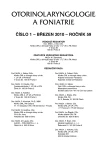-
Medical journals
- Career
Late Results of Cholesteatoma Surgery in Children
Authors: B. Kohútová-Hartmannová; Marian Sičák
Authors‘ workplace: Klinika otorinolaryngológie a chirurgie hlavy a krku, Ústredná vojenská nemocnica SNP, Fakultná nemocnica, Ružomberok
Published in: Otorinolaryngol Foniatr, 59, 2010, No. 1, pp. 10-14.
Category: Original Article
Overview
Introduction:
Cholesteatoma in children is considered more aggressive than in adults. The aim of an otosurgeon is to remove cholesteatoma safely and completely and at the same time to preserve anatomy and physiology of the ear.Material and methods:
We are evaluating a group of 38 cholesteatomas in the children who were operated at ORLCHHK in Ruzomberok in 1996-2006. The patients have been monitored to show in what extent the eradication of cholesteatoma, audiological results as well as tympanoplasty have been successful.Results:
By canal wall up (CWU) technique, 29 ears were operated on and canal wall down (CWD) technique was used in 3 ears. 6 ears did not require antrotomy and/or antromastoidectomy and they were resolved by cleaning tympanic sinus and/ or atticus. We detected recurrent cholesteatoma in 17 ears (45 %). We re-operated in 4 cases because of unsatisfactory result of tympanoplasty. 42 % ears were without failure of hearing postoperatively, and decrease aier-bone gap (ABG) to 20 dB was recorded in 21 % ears. We evaluated ABG 25-40 dB in 37 % ears. There have been no records of ABG more than 40 dB postoperatively.Conclusion:
Nowadays, surgery of cholesteatoma is not only about safety and radical removal of pathological tissue. Functional, minimal invasive surgery is optimal, which enables preservation of most of the original structures and thus it offers the best conditions for reconstruction.Key words:
cholesteatoma, child, recurrent cholesteatoma, canal wall down, canal wall up, combined approach tympanoplasty.
Sources
1. Dodson, E. E., Tashisaki, G. T., Hobgood, T. C., Lambert, P. R.: Intact canal wall mastoidectomy with tympanoplasty for cholesteatoma in children. Laryngoscope, 108, 1998, s. 997-983.
2. Edelstein, D. R., Parisier, S. C., Chute, P., Ahuja, G. S., Wenig, S., Juarbe, Ch., Kaye, S. M.: Cholesteatoma in the pediatric age group.Ann Oto Rhinol. Laryngol., 97, 1998, s. 23-29.
3. Kovaľ, J.: Chirurgická liečba stredoušného zápalu. USPO, Bratislava, 1998.
4. Sičák, M., Hartmannová, B.: CAT-tympanoplastika kombinovaným prístupom v liečbe cholesteatómu. Choroby hlavy a krku, 2003, s. 37-41.
5. Sheehy, J. L.: Cholesteatoma surgery in children. Am. J. Otol., 1985, 2, s. 170-172.
6. Sheehy, J. L., Brackmann, D. E., Graham, M. D.: Cholesteatoma surgery: rezidual and recurrent disease.Am. Otol., 86, 1977, s. 451-462.
7. Stern, S. C., Fazekas-May, M.: Cholesteatoma in peditris population: prognostic indicators for surgical decision making. Laryngoscope, 102, 1992, s. 1349-1352.
8. Syms, M. J., Luxford, W. M.: Managment of cholesteatoma: status of the canal wall. Laryngoscope, 113, 2003, s. 443-448.
9. Tos, M., Lau, T.: Late results of surgery in different cholesteatoma types. ORL J. Otorinolaryngol. Relat. Spec., 51, 1989, s. 33-49.
10. Tos, M.: Manual of middle ear surgery. 1, Thieme, New York, 1993.
11. Tos, M.: Manual of middle ear surgery. 2, Thieme, New York, 1995.
Labels
Audiology Paediatric ENT ENT (Otorhinolaryngology)
Article was published inOtorhinolaryngology and Phoniatrics

2010 Issue 1-
All articles in this issue
- The Contribution of Binaural Amplification to Speech Intelligibility – Effect of the Previous Adaptation to Monaural Amplification
- The Contribution of Binaural Amplification to Speech Intelligibility – Effect of Age
- Late Results of Cholesteatoma Surgery in Children
- Bipolar Coagulation BiClamp® in the Operation on Thyroid Gland
- Importance of Neck Nodes Dissection in the Organ Preserving Protocol
- Reflux Finding Score
- The Relationship between Human Papillomavirus Infection and the Etiology of Tonsillar Cancer
- Solitary Fibrous Tumor of Hypopharynx
- Otorhinolaryngology and Phoniatrics
- Journal archive
- Current issue
- Online only
- About the journal
Most read in this issue- Reflux Finding Score
- Importance of Neck Nodes Dissection in the Organ Preserving Protocol
- Late Results of Cholesteatoma Surgery in Children
- Bipolar Coagulation BiClamp® in the Operation on Thyroid Gland
Login#ADS_BOTTOM_SCRIPTS#Forgotten passwordEnter the email address that you registered with. We will send you instructions on how to set a new password.
- Career

